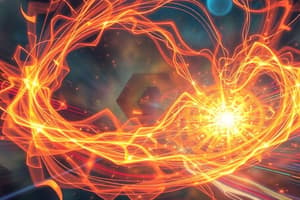Podcast
Questions and Answers
What is the primary characteristic of contact forces?
What is the primary characteristic of contact forces?
What type of motion is exhibited by a pendulum?
What type of motion is exhibited by a pendulum?
What does the slope of a position vs. time graph represent?
What does the slope of a position vs. time graph represent?
How does mass affect the motion of an object according to the second law of motion?
How does mass affect the motion of an object according to the second law of motion?
Which of the following best describes gravitational force?
Which of the following best describes gravitational force?
Which statement is true regarding the relationship between friction and motion?
Which statement is true regarding the relationship between friction and motion?
What is the main influence on motion in projectile motion?
What is the main influence on motion in projectile motion?
Study Notes
Understanding Science Concepts: Forces and Motion
Key Definitions
- Force: A push or pull exerted on an object, measured in Newtons (N).
- Motion: The change in position of an object with respect to time.
Types of Forces
-
Contact Forces: Require physical contact between objects.
- Friction: Resists motion between surfaces.
- Tension: Force transmitted through a string or rope.
- Normal: Supports the weight of an object resting on a surface.
-
Non-Contact Forces: Act at a distance.
- Gravitational: Attraction between masses.
- Electromagnetic: Forces between charged particles.
- Nuclear: Forces that hold protons and neutrons together in an atom.
Newton's Laws of Motion
- First Law (Inertia): An object at rest stays at rest, and an object in motion continues in motion unless acted on by a net force.
- Second Law (F=ma): The acceleration (a) of an object is directly proportional to the net force (F) acting on it and inversely proportional to its mass (m).
- Third Law (Action-Reaction): For every action, there is an equal and opposite reaction.
Types of Motion
- Linear Motion: Movement in a straight line.
- Rotational Motion: Movement around an axis.
- Periodic Motion: Repeats at regular intervals (e.g., pendulum).
- Projectile Motion: Motion of an object thrown into the air, influenced by gravity.
Factors Affecting Motion
- Mass: Heavier objects require more force to change their motion.
- Friction: Affects the speed and direction of motion.
- Gravity: Provides a constant force that influences all objects with mass.
Graphing Motion
- Position vs. Time Graph: Shows how position changes over time. Slope indicates speed.
- Velocity vs. Time Graph: Shows how velocity changes over time. Slope indicates acceleration.
Applications of Forces and Motion
- Engineering (designing structures and vehicles).
- Sports science (improving performance through understanding motion).
- Everyday life (navigating and interacting with physical objects).
Key Definitions
- Force: A push or pull measured in Newtons (N) that influences the motion of an object.
- Motion: Describes the change in an object's position over time.
Types of Forces
-
Contact Forces: Require direct physical interaction.
- Friction: Opposes motion between two surfaces, impacting movement speed.
- Tension: Force transmitted through a rope or string during stretching.
- Normal Force: Acts perpendicular to the surface, supporting an object's weight.
-
Non-Contact Forces: Act over a distance without physical touch.
- Gravitational Force: Attraction between two masses, a key factor in the motion of celestial bodies.
- Electromagnetic Force: Interactions between charged particles, essential in electricity and magnetism.
- Nuclear Force: Binds protons and neutrons in the nucleus, vital for atomic stability.
Newton's Laws of Motion
- First Law (Inertia): Objects maintain their state of rest or uniform motion unless influenced by a net external force.
- Second Law (F=ma): The acceleration of an object is influenced by the net force acting on it and is inversely related to its mass.
- Third Law (Action-Reaction): Every action results in an equal and opposite reaction, fundamental in understanding interactions.
Types of Motion
- Linear Motion: Motion along a straight path.
- Rotational Motion: Movement around a fixed axis.
- Periodic Motion: Repeats at consistent intervals, such as a swinging pendulum.
- Projectile Motion: Motion of an object projected into the air, predominantly affected by gravitational force.
Factors Affecting Motion
- Mass: More massive objects need greater force for changes in motion.
- Friction: Impacts both the speed and direction of moving objects.
- Gravity: A constant force affecting all objects with mass, crucial in influencing falling and orbiting bodies.
Graphing Motion
- Position vs. Time Graph: Represents changes in position over time; the slope indicates the object's speed.
- Velocity vs. Time Graph: Displays changes in velocity over time; the slope represents acceleration.
Applications of Forces and Motion
- Engineering: Essential in creating safe and functional structures and vehicles.
- Sports Science: Enhances athletic performance by analyzing motion principles.
- Everyday Life: Influences how people navigate and engage with their environment.
Studying That Suits You
Use AI to generate personalized quizzes and flashcards to suit your learning preferences.




